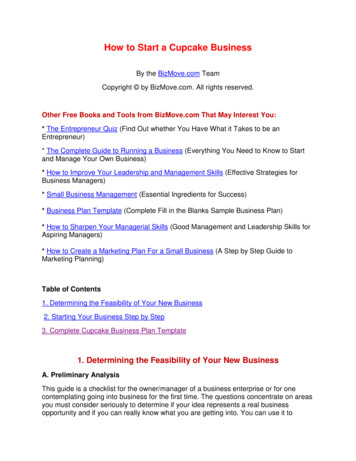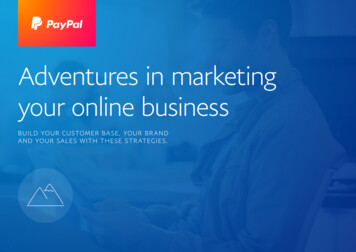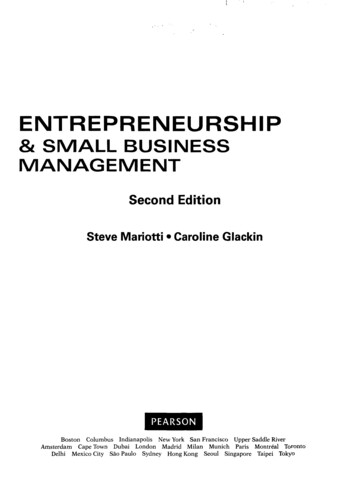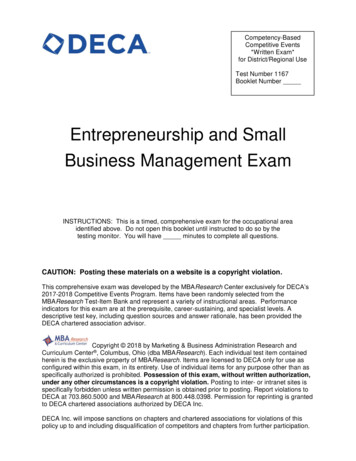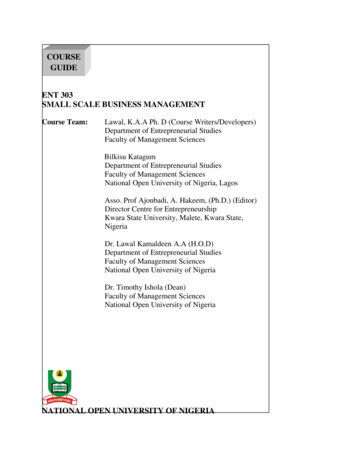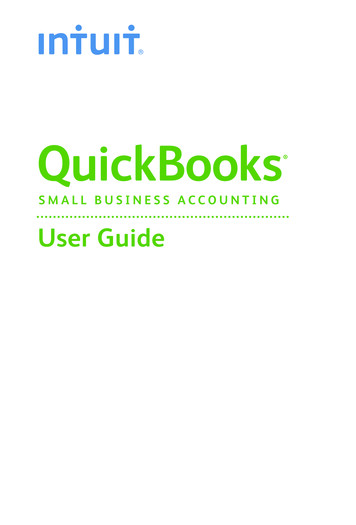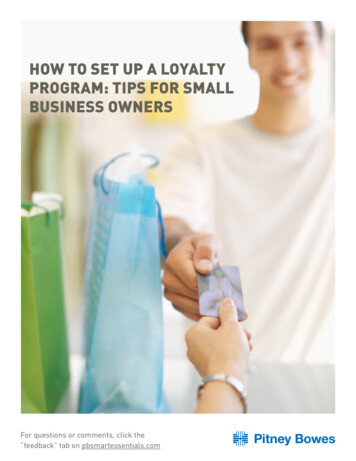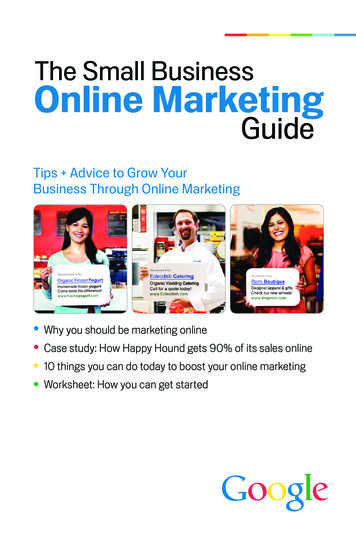
Transcription
The Small BusinessOnline MarketingGuideTips Advice to Grow YourBusiness Through Online MarketingWhy you should be marketing onlineCase study: How Happy Hound gets 90% of its sales online10 things you can do today to boost your online marketingWorksheet: How you can get started
Contents4. Why Your Business Needs to Market Online6. 10 Ways to Use the Internet to Grow Your Business9. Measuring Your Results10. Tip a Day: Map Your Path to Online Success12. Case Study: Happy Hound13. Online Marketing: Something for Every Business14. Key Terms16. Worksheet2Suzanne Golter of Happy Hounddog day care and boarding
WelcomeEvery day we hear from business owners who think they need specialskills to reach new customers online. Overwhelmed by the number andseeming complexity of online marketing options, they sit on the sidelines,eager to get in the game but confused about where to start.Sound familiar? If so, this guide is for you.Whether you’re new to online marketing or just looking to do it better, theadvice in this guide can help you reach your business goals. You’ll learn: How many new customers you can find online 10 ways to use the Internet to grow your business How to measure your results How one small business gets 90% of its sales online Key terms and what they meanWe’ve also created a daily tip sheet filled with ideas to help you get startedas well as marketing plans for four different types of businesses. Getstarted right away by filling out the worksheet to create an action plan.As with anything else, practice and persistence will lead to onlinemarketing success. We hope this guide starts you on the path tobecoming an online superstar.Sincerely,Brynn ZuccaroNorth America Business MarketingGoogle3
Why Your Business Needs to Market OnlineDid you know that 94% of consumers research productsonline before buying? Or that three out of five people usesearch engines as a go-to shopping resource?*HOT TIPAdWordsSee the KeyTerms section foran explanationof onlineadvertisingterminology.There is no longer any doubt that buyers go onlineto research and purchase products and services.Companies that have websites and market online canreap the rewards of connecting with these shoppers.The hardest part of doing anything can be gettingstarted, so create your game plan now to start gettingthe payback from marketing online. Here’s how:Set your goalOnline marketing can do many things for your business.Choose one or two objectives for starters. For example,do you want to drive visitors to your website, generatemore foot traffic to your store or restaurant, or gatheremails for a newsletter?Identify your targetBe clear about the buyers you want to reach. What dothey care about most? What are their problems? Havethey purchased from you before? Are they currentlybuying from a competitor? Also consider their gender,hobbies, location and other specifics; these can all helpyou determine the best ways to reach them, as well asthe messages that will work best.DID YOU KNOW?The good news for your business is that online marketing doesn’t have to becomplicated, time-consuming or expensive. Consider that: Online outreach often costs less than offline efforts. Launching new campaigns can be lightning fast – meaning that potentialcustomers will see your campaign quickly. Changes and updates can be made instantly, usually at minimal cost. Measurement tools quickly show what’s working and what’s not.* Source: 2010 Compete Online Shopper Intelligence Study4
The Small Business Online Marketing GuideLearn about current customersIf you have a website, ask your current customers howthey found it. If not, ask them where they go online now.This insight can help you focus your efforts.Check out competitorsJust because a competitor is doing it doesn’t mean itworks – but it might. Reviewing what your competition isdoing can help you create your own unique approach.Set a strategyTaking the time to think through your plan before you begincan dramatically improve your results. Choose one or twotactics that work within your budget, make sense for youraudience and that you can commit the time to manageeffectively. Many successful online marketers take a “testand refine” approach to get the greatest payback.Track your resultsOnline marketing makes it easy to measure programperformance; take advantage of this by closely monitoringthe response to your marketing programs. Increase yourinvestment in the programs that work well and revisecomponents of programs that aren’t working as well asyou would like to see how your program improves.SPOTLIGHTTwiddy &Company Realtors(www.twiddy.com)in Duck, NorthCarolina, wantedto increase thenumber of onlinebookings for itsvacation properties.Using searchadvertising,they increasedbookings wFocusSetStrategy5
10 Ways to Use the Internet to Grow Your BusinessFrom affiliate marketing to online classifieds, there aremany ways to build your business online. Here’s a look atten popular online marketing options:AdWordsSPOTLIGHTThis display adis a great exampleof an effectivevideo bannerfeaturing smallbusiness ownerBud Duong. Seeother displayad examples at(www.google.com/adwords/displaynetwork)61. Local listings and classifieds. Create yourbusiness listing on listing sites such as Citysearchto ensure that consumers searching for nearbybusinesses find yours. Some listings allowyou to promote offers such as sales and newproducts. Customer review sites are basically localdirectories like Yelp that allow users to expresstheir opinions about businesses.2. Search advertising. Search advertising is amethod of placing online ads on Web pages nearsearch engine results. With AdWords (www.google.com/adwords), you can deliver your message atthe moment someone is searching for the typeof product or service you offer. Choose keywordsthat relate as closely as possible to your offeringsso you receive the most likely prospects. For CPCads, you pay only when someone clicks on your ad.3. Contextual ads. Contextual advertising takesdisplay ads to the next level, by placing them onsites related to your offerings; for example, if yousell sporting goods, your ad may perform betteron sports-related sites. Services are available thatautomatically distribute ads to sites basedon the content of those sites.4. Display ads. You’ve probably seen thedancing aliens; that’s a display, or banner, ad.Do-it-yourself display ad builders, includingGoogle’s AdWords display ad builder(www.google.com/displaynetwork) can helpdesign your ad. You can also distribute your displayad via ad networks and ad management systems.5. Geotargeting. Geotargeting simply meansadvertising to prospects in specific locations –which could be very useful, for example, if yousell dresses only in Dallas. One way to get startedis to create a listing on Google Places(http://places.google.com/business).
The Small Business Online Marketing GuideOnline Ad Payment OptionsFEE STRUCTURECost Per ThousandImpressions (CPM)Cost Per Click(CPC)Cost Per Action /Acquisition (CPA)WHEN YOU PAYCOST PER LEADWhen consumers see your ad, regardlessof whether they click on it. CPM is thecost per 1,000 views of your ad. When someone clicks on your ad. When someone takes an action you want, such asdownloading a white paper or buying a product. 6. Group buying. Connect with new customersthrough programs that offer multiple buyerscollective purchasing deals. There are manypopular group buying sites available to use.7. Mobile marketing. Many smartphones andmobile devices provide web browsing, GPS,cameras and video capabilities. This meansyou can develop creative promotions with textmessages and location-based social networks.8. Social networking sites. Cultivate newbusiness through social networking sites wheremembers share stories and recommend productsand services.9. Affiliate marketing. Affiliate marketing lets youget other businesses to drive prospects to yourwebsite. Some affiliates may allow you to set upa store on their domains, such as comparisonshopping sites.10. Online videos. Reach new audiences byposting videos on video-sharing sites.The best videos tend to be short (less than threeminutes) and have an offer, such as a free copyof a report or a product discount, to motivateviewers to take action. MobileDemand is one ofmany small businesses with a YouTube channelto help spread company news and information.HOT TIPPromote specificproducts in yourads. People whoresearch modelnumbers onlineare usuallycloser to makinga purchase.7
10 Ways to Use the Internet to Grow Your BusinessComparing Online Marketing nglevelsLocal listings andclassifieds Search advertising Contextual Geotargeting Display ads AdWordsGroup buyingMobile marketingSocialnetworking sites HighlymeasureableSupportsgraphicsor videoCan includeGood forcustomerspecial offers reviews Affiliate marketing Online videos Effective Highly effectiveHOW MUCH SHOULD YOU SPEND ON MARKETING?The amount varies by industry, business size and how much you want to growyour business.The Small Business Administration and SCORE (Counselors to America’s SmallBusiness) put it at between 2% and 10% of sales.Depending on your business model, you could spend half of your marketing budgeton offline (print ads, brochures, telemarketing) and half on online (search marketing,display ads, mobile). The more online oriented your business is, the more you shouldconsider increasing your online spending. Your return on investment (ROI) willdepend on your offer and who you reach out to (current customers or prospects).8
The Small Business Online Marketing GuideMeasuring Your ResultsOnline marketing generates a wealth of datato let you assess and refine your marketingprograms. Start with these easy-to-trackperformance measures:Website analyticsDig into your visitor data to see where your most promisingleads come from. The quality of your traffic usually trumpsquantity – for example, a referral site that delivers fourbuying customers may be worth more than one that delivers50 window shoppers. Google Analytics (www.google.com/analytics) is a great place to start, and it’s free.ClickthroughsThe basic measure of an online ad’s impact is how manypeople click on it to visit your site. Clickthrough rates areoften strongest with a compelling visual, message or offer,combined with placement on the right sites.ConversionsHow many people who see your ads “convert” into buyersor take a specific action, such as subscribing to yournewsletter? Take a look at your conversion rates to helpdetermine which outreach efforts are most cost-effective.Phone Number TrackingUsing a unique phone number in your ads lets you seeexactly how many calls your campaign has generated.Platforms like AdWords Call Metrics (www.google.com/ads/innovations/callmetrics.html) make this easy byassigning a different number to each campaign. Thisfeature, which lets you track calls by ad and shift yourspending, provides clear evidence that online marketingcan lead to real leads, customers and offline success.Landing pagesA landing page is any page on your website where trafficis sent specifically to prompt an action. For example, youmight create different landing pages for different displayads. Landing pages let you customize your message andtrack program performance accurately. Keep the landingpage simple — if you want visitors to buy, make that thefocus of the page; don’t distract them with newsletter links,webcasts, blogs, Facebook links or cute puppy videos.WATCHOUTChanging yourmarketingtactics toofrequentlymay diminishyour long-termresults.9
Tip a Day: Map Your Path to Online SuccessOnline marketing can make your head spin. There are countless options, experts, trendsand changes. That’s why we created this Tip-a-Day feature. Bit by bit, following easy-totake steps, you can start marketing your company online or step up your current efforts.AdWords10MONDAYTUESDAYWEDNESDAYWEEK 1Get a website. This maytake more than 30 minutes.If you want a basic site, getstarted with a templatefrom an online websitedevelopment tool.Claim your Google Placeslisting. Put your businesson the map with free GooglePlaces (http://places.google.com/business). Easily addphotos, coupons.Survey your customers.Put together an onlinesurvey and find out whatyour customers thinkabout your products,your customer serviceor whatever else you arecurious about.WEEK 2Start a blog. Blogs are agreat way to demonstrateyour expertise and startconversations with allkinds of visitors – who maybecome great customers.Simplify the shoppingprocess. Many sites makeit difficult for shoppers tocomplete basic tasks. Haveothers test your site andfix what they point out asstumbling blocks.Test paid search. Set up aGoogle AdWords account(www.google.com/adwords)and create a search ad.Include prices, special offersand unique selling points.WEEK 3Begin an affiliate program.To start an affiliate program,you will need trackingsoftware or outsourceit to a third party likeGoogle Affiliate h an emailnewsletter. Update yourcustomers with importantcompany news and industryevents. Online email servicescan help you get started.Know your customers.Google Analytics(www.google.com/analytics)can help you measure yourprogram response andtrack your Flash, video andsocial networking sites andapplications.WEEK 4Build a forum. Offer adviceand tips to build trust andgenerate sales. Set up yourown message board withstandard software or trya hosted forum service.Add a sitemap. Sitemapshelp make sure the searchengines look at every pageof your website. You can alsosubmit an XML Sitemap toGoogle (www.google.com/webmasters).Use clear navigation. Stepback and look candidly atyour site. Can first-timevisitors find the informationthey’re looking for?If not, change it.
The Small Business Online Marketing GuidePlan on 30 minutes or less a day. Over thecourse of a month, you will be surprised athow much you accomplish!THURSDAYFRIDAYSATURDAY / SUNDAYOffer freebies. Offer afree bonus with an orderto anyone who buys fromyou. If you sell to otherbusinesses, a free specialreport can boost yourcredibility and drive sales.Get social. Use socialmedia sites to connect withprospects or customers inyour target demographicby sharing information andengaging in conversations.Create a banner ad. UseGoogle’s AdWords displayad builder to create yourad (www.google.com/displaynetwork); then placeit using an ad network.Review your “About Us”information. Does yours saywho you are and what youdo in easy-to-understandlanguage? If not, change it.Add on-site productreviews. Let your customersrate your products or solicittestimonials frompast customers.Use your email signature tosell. Don’t let your emails goto waste. Include the URL ofyour website or sales pagein your signature (sig) file.Add site search. Helpvisitors find what they’relooking for by adding asearch function likeGoogle Site l the benefits. Lookat how you describe yourproducts or services. Does itsay how it solves a problem?Remember: People buyresults not products.Get listed. Like the phonebook, online directoriescan help categorize yourproducts and make it soothers can easily findyour business.Record a video. Use short(two-minute) videos toexplain how to do a task thatrelates to your business.Post your video on YouTube(www.youtube.com).Get involved. Get activein your small businesscommunity – your chamberof commerce, local eventsor other networkingopportunities. Onlinenetworking services canhelp you network andplan meetings.Make an e-book. Combineseveral of your articles intoan e-book and give it away.You need a word processingprogram that turns adocument into a PDF,or use an online selfpublishing service.11
Case Study: Happy Hound Gets 90% of its Sales OnlineAdWordsSuzanne GolterSITUATION New businessneeded to attractcustomers Owner wantedeffective onlinemarketing that shecould manage herselfOUTCOME Google AdWordsdelivers 90% ofcustomers Success offersblueprint forsecond locationWhen Suzanne Golter opened her dog day care andboarding business in an Oakland, California, warehousein 2004, she knew she had a cheerful and healthy spacefor dogs. Happy Hound featured innovations like a stateof-the-art ventilation system, and a webcam so ownerscould check on their pets. Now, Golter just neededcustomers. As a one-woman show, spreading the wordhad to be something she could manage by herself.ActionGolter knew that many potential clients would searchonline for a service like hers, so she created a GoogleAdWords account and began posting short ads. “I setup my primary means of advertising in one sitting,”she says.Golter first used AdWords’ geographic targeting tocast a wide net, but she quickly scaled back to focuson the Oakland-San Jose area. She also tried an emailnewsletter and ads in national dog-related magazines,but found that they didn’t perform as well.Golter also claimed her Google Places page andupdated her information, and she likes to use socialmedia to interact with customers. She posts photosof dogs and promotes Happy Hound events andfundraisers on social networks and she has receiveddozens of customer reviews on online review sites.ResultsToday, Happy Hound is filled with dogs, and Golterhas a long waiting list. AdWords accounts for 90% ofher business, bringing in about 40 new clients eachmonth. “AdWords helped me grow so quickly here,I know that when I expand, it will help me fill mynext facility,” she says.HOT TIPGo online and watch the Happy Hound video andother success stories at: (https://www.google.com/intl/en us/adwords/select/success.html)12
The Small Business Online Marketing GuideOnline Marketing: Something for Every BusinessOnline marketing success stories can sometimes leave a smallbusiness owner wondering if it would really work for them. What ifyou don’t have a website — can you still reach customers online?What about online-only companies? Fear not. With all the onlinemarketing options available, one (or more) is likely to help almostany business. Here are strategies to help four particular kinds ofbusinesses. Use them to help start or improve your online marketing efforts.STOREFRONT BUSINESSMain Street is full of companies with aprominent storefront and no website.Gift shops, restaurants, wine storesand other storefront businesses canuse an online presence to drive offlinesuccess. Try:LOCAL BUSINESSTraditional companies – plumbers,real estate agents and the like cangain loads of payoff from onlinemarketing by making it easy forcustomers to find them. Try:1. Claiming your Google Places page.2. Promoting your business oncustomer review sites.3. Creating a blog.4. Offering incentives for locationbased activities, such as visitingyour store multiple times.1. Claiming your Google Places page.2. Submitting your site to onlinedirectories. Don’t forget any tradeorganizations you belong to.3. Using social media to connect withtarget customers and prospects.4. Setting up a search advertisingaccount and place a geotargeted ad.ONLINE-ONLY BUSINESSONLINE & OFFLINE BUSINESSOnline retailers can spread the wordabout their offerings, stay connectedwith customers and keep trafficflowing in the virtual door withonline marketing. Try:For businesses that are online andoffline – think a bed and breakfastor a toy store – the sky is the limit forattracting business and connectingthe two. Try:1. Creating a blog.2. Sending a newsletter.3. Making a banner ad and placeit on an ad network.4. Starting an affiliate program.1. Claiming your Google Places page.2. Collecting email addressesfrom physical visitors to start ane-newsletter.3. Distributing online couponsthrough your website.4. Setting up a search advertisingaccount and place a geotargeted ad.13
Key TermsAdWordsOnline marketing terminology can seem like a newlanguage. Let us translate for you.Ad Group: A collection of ads within a campaign thatcorresponds to a group of related keywords.Ad Network: An advertising company that connectsbusinesses wanting to run ads with websites that willhost ads. Ad networks sell and serve most banner ads.Affiliate Marketing: A marketing tactic in which onecompany pays another for each visitor or customerbrought by its marketing efforts.Banner Ad: A type of ad, usually with graphics, thatappears on a web page and links to an advertiser’swebsite.Campaign: A component of your account that allowsyou to focus your advertising on specific products orservices. Each campaign can contain multiple ad groups.Clickthrough Rate (CTR): The number of clicks an adreceives divided by the number of times the ad is shown.HOT TIPIf you want to trygroup buying,be ready tooffer significantdiscounts —sometimesmore than 50%.14Contextual Advertising: A type of advertising based onthe content displayed to the user.CPA, CPC, CPM: Cost per action / acquisition (CPA) isan online payment model by which advertisers pay foreach action completed because a visitor clicked on theirad. With cost per click (CPC), advertisers pay for each adclickthrough. With cost per thousand (CPM), advertiserspay for every 1,000 impressions.Flash: A software plugin that enables browsers to playmultimedia animations, such as video.
The Small Business Online Marketing GuideGeotargeting: A method of delivering online ads basedon the physical locations of web surfers.Google AdWords: Google’s advertising program basedon cost-per-click pricing.Group Buying: When a group of consumers cometogether to leverage the group’s size in exchange fordiscounts on products or services.Impressions: The number of times an ad is viewed. Oneimpression is one banner ad displayed on one web page.Keyword: Words used for a given ad group to targetpotential customers.Landing Page: A web page where visitors are takenafter they click on an ad or a search result. This maybe a website home page or a unique page developedspecifically for a marketing campaign.HOT TIPAsk advertisingpartners howyou can receivemore fromtheir services.Chances arethey can tell youabout successfulstrategies fromother clients.Negative Keyword: Specific terms that you can excludein paid search results. For example, if you select “freetrial” as a negative keyword, your ad will not show as aresult of any search including both “free” and “trial.”Rich Media: A type of technology that includesgraphics, audio or video within an ad.Search Engine Marketing (SEM): The practice ofpromoting a website through a search engine.WATCHOUTDon’t focus your ad on the features of yourproducts or services. Instead, communicate thebenefits your potential customers will receive.15
Worksheet: How to Get StartedNow that you’re thinking about new ways to grow your business online, use thisworksheet to choose the most effective vehicles to promote your products andservices. By defining your goals and assessing the resources, you’ll help improve yourfollow-throughand increase your chances for success.AdWordsSECTION 1. STRATEGY1. I want to:Increase awareness of my companySell more to existing customersFind new customersOther 2. My customers are primarily:LocalIn my stateIn the United StatesGlobal3. Most of my customers found my business by:Word of mouth / referralsPrint advertisementsIn-person presentationsRadio / TV advertisementsSearch engines / online adsDirect mailPhone callsNews coverage / press releasesYellow Pages / other directoryFoot traffic / walked byBillboards / other signageOther 4. My customers visit these websites regularly: Search engines (List Names, URLs): Social media sites (List Names, URLs): Shopping sites (List Names, URLs): Community sites (List Names, URLs): Other (List Names, URLs): 16
The Small Business Online Marketing Guide5. Internal assets I can use to build my business online:Website / Ecommerce storeLanding pagesBlogStaffer(s) available to helpOnline videosStaffer(s) available to answer callsSpecial offers, such as coupon codesOther 6. Online tactics that may fit my business include:e.g., I can write a strong offer to help move a slow-moving item. Local listings and classifieds (Rationale?): Google AdWords (Rationale?): Contextual ads (Rationale?): Geotargeting (Rationale?): Display ads (Rationale?): Group buying (Rationale?): Mobile marketing (Rationale?): S ocial networking sites (Rationale?): Affiliate marketing (Rationale?): Display ads (Rationale?): Online videos (Rationale?): 17
Worksheet: How to Get Started7. Companies I follow that do these activities well:Business Name:Online Activity:e.g., Acme Inc.Makes video posts on YouTube.Lessons Learned:I should use videos to drive website traffic.
AdWords Online Marketing The Small Business Guide Why you should be marketing online Case study: How Happy Hound gets 90% of its sales online


